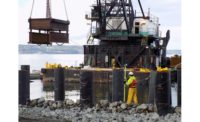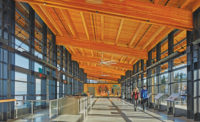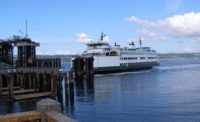Building the first new terminal in 40 years for the country’s largest ferry system, operated by the Washington State Dept. of Transportation, entailed grappling with tricky site conditions and culturally sensitive concerns. The $187-million Mukilteo Ferry Terminal required multiple contracts and a unique stormwater system.
The terminal is replacing a 63-year-old structure that is part of State Route 525, Washington State Ferries’ (WSF) second-busiest ferry route with 4 million riders annually and an expected walk-on ridership increase of 124% by 2040. Hemmed in by other development, the new terminal is built one-third of a mile east of the existing structure on what was an abandoned World War II-era U.S. Air Force fueling station.
But environmental contamination wasn’t the only concern, as the site is also steeped in cultural significance. It was the signing location of the 1855 Point Elliott Treaty with dozens of Native American tribes and nations.
The combination of culturally sensitive land with potentially contaminated areas required raising the terminal site 7 ft. “We needed to be very sensitive to that cultural significance, and that really drove so many decisions for the project,” says Dan Alire, project engineer for KPFF Consulting Engineers.
“It certainly had its challenges,” Alire says about the requirement that there be virtually no on-site excavating. The team had to find a “happy medium” in elevating the site as much as possible to allow burying all utilities without excavating, and to protect against coastal flooding, yet not overextend the budget with expensive fill. A tidal range of up to 18 ft made design trickier, as the overhead passenger loading bridge had to work at both low and high tide, with the proper slope to accommodate the Americans With Disabilities Act. “It was balancing a lot of things to get the finished grade elevations,” Alire says.
Bryant Bullamore, WSF construction manager, says test borings set the boundaries of the culturally sensitive and environmentally delicate areas, and an archeologist on site ensured they followed all tribal agreements.
The site required a unique stormwater system consisting of bioretention facilities, modular wetlands and a large pervious pavement sand filtration system, all working together to treat water. “We built up this whole area,” says Nick Miller, project manager with IMCO Construction, the general contractor for the landside portion. “We put in basically a huge filter. It is a pretty massive area draining out, cleaning and discharging.”
Crews uncovered unexpected site conditions. The existing shore riprap was thought to be up to 5 ft thick, but as teams started drilling for pile placement, it was found to be up to 10 ft. “We had to do a lot of extra work to remove that and armor that slope,” Bullamore says. “That was one of the big challenges at the beginning.”
Multiple Contracts
The project, which started in 2017 and wraps up this spring, includes the terminal, a maintenance building, passenger overhead loading, a toll plaza with four toll booths and seven holding lanes, an in-water docking and loading structure, a transit center for connections to buses and trains and improvements to intersections and the waterfront promenade.
Because of the concerns about work stoppages involved with the site’s sensitivity, the project was broken into four different contracts to ensure it moved forward. Bullamore says this added complications in coordination, but the contractors worked well together and kept the project moving forward to an on-time opening of the building. He says it also opened the project to contractors with unique specialties.
Orion Marine Group built the foundation trestle, a high-risk portion, while IMCO handled the deep stormwater system with a trenchless technique to avoid disturbing the site. Manson Construction executed the remainder of the marine work, and IMCO, in a separate contract, constructed the building, roadwork and utilities. “The different contracts and phasing were an important part of how this kept moving forward and how we mitigated some of the major risks we knew existed,” Alire says.
The coordination didn’t stop with contractors, as multiple state agencies, the city of Mukilteo and 11 federally recognized tribes were all part of the project. “There are so many people, there are so many unique parts,” Alire says.
The in-water work first required dredging 23,500 cu yd and removing 3,600 creosote piles, 4% of the creosote piles in the Puget Sound. Charlie Torres, WSF project manager, says Orion was able to complete that work in one year instead of the projected two.
The biggest challenge was implementing a new structural system to handle seismic considerations of the slope and movement up to 7 ft in a traditional system. By working with the University of Washington, the team devised a concrete-filled steel tube system to control movement with a fixed pile approach, limiting displacements to less than one foot. “It is something you would not do on most projects because it is expensive,” Alire says, “but it met our criteria here.”
During placement of large-diameter shafts, some up to 7 ft in diameter, the first started sinking in an unexpected way. “It was a quick all-hands-on-deck [moment],” Alire says. “We got the shaft stabilized and finished construction.” They solved the issue by drilling out the interior of the pile and placing a slurry mix inside with enough hydrostatic pressure to stabilize the shaft before installing the remainder of the concrete casing.
Throughout the marine work, Kelli Rider, Manson Construction project engineer, says it was a technical project with unique elements such as heavy lifts, tight tolerances and tidal work areas. The steel items were fabricated off-site and set in place, including a nearly 400,000-lb vehicle transfer bridge that make the pick geometry challenging.
“All the structural steel items have tight tolerances in order for the system, both the vehicle transfer span and the overhead loading cab, to function correctly at any tidal elevation,” Rider says. “Coordination on this project was more extensive than most. All elements had to be installed in a way to not conflict with each other.”
The terminal building—designed in the form of a 30-ft by 100-ft Coast Salish longhouse with a large gathering hall, with views of the water and sustainable features—is aiming for LEED Gold certification and includes photovoltaics, rainwater harvesting and natural building ventilation.
The building opened to passenger traffic on Dec. 29, 2020, but work continues into spring to remove the previous terminal and old holding lanes for a new connection to Highway 525.












Post a comment to this article
Report Abusive Comment